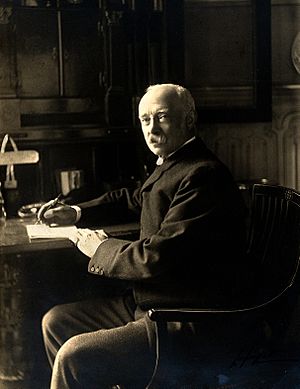Montagu Cotterill facts for kids
Quick facts for kids
Sir
Joseph Montagu Cotterill
CMG, FRCSEd, R.A.M.C
|
|
|---|---|
 |
|
| Born | 23 November 1851 Kemp Town, Sussex, England
|
| Died | 30 December 1933 (aged 82) Edinburgh, Midlothian, Scotland
|
Sir Joseph Montagu Cotterill (born November 23, 1851 – died December 30, 1933) was a skilled surgeon. When he was a young man, he was also a talented cricket player. He even played one game for the England team. Later, he became a well-known surgeon in Edinburgh, Scotland. He also served as the President of the Royal College of Surgeons of Edinburgh.
Contents
Early Life and Education
Joseph Cotterill was born in Kemp Town, Sussex, England. His father, Henry Cotterill, was a bishop. He was first a bishop in South Africa and later in Edinburgh, Scotland.
Joseph went to school at St. Andrew's College, Grahamstown in South Africa. He also attended Brighton College in Sussex. In 1871, he started studying medicine at the University of Edinburgh Medical School. He won awards for his work in surgery and pathology.
Joseph was a great athlete. He was the captain of the Edinburgh University rugby team. He was also good at golf, billiards, and shooting. While training to be a surgeon, he also played first-class cricket.
Cricket Career
Joseph Cotterill was a right-handed batsman. He also bowled right-arm medium pace. He played his first "first-class" cricket game in 1870 for Sussex. This type of cricket is the highest level of the sport.
He played many games for Sussex between 1870 and 1888. He even captained the Sussex team in 1874 and 1875. In 1876, he played one game for the England against Gloucestershire.
In his 27 games for Sussex, he scored 1,328 runs. His average score was 28.86 runs per game. He scored eight "half-centuries" (50 runs or more) and one "century" (100 runs or more). His highest score in a single game was 191 runs against Kent in 1875.
Here are some of his overall cricket statistics:
| Competition | First-class cricket |
| Matches | 37 |
| Runs scored | 1,708 |
| Batting average | 27.11 |
| 100s/50s | 1/11 |
| Top score | 191 |
| Balls bowled | 377 |
| Wickets | 6 |
| Bowling average | 35.66 |
| 5 wickets in innings | - |
| 10 wickets in match | - |
| Best bowling | 2/44 |
| Catches/stumpings | 16/- |
Surgical Career and Later Life
After finishing his training, Joseph Cotterill became a surgical tutor. In 1878, he earned his FRCSEd, which is a special qualification for surgeons. He became an assistant surgeon at the Royal Infirmary of Edinburgh in 1883. He became a full surgeon in 1897 and a consulting surgeon in 1912.
He was one of the first doctors to perform neurosurgery. This is a special type of surgery on the brain and nervous system. He worked with a famous neurologist named Sir Byron Bramwell.
When World War I began, he became a senior surgeon. He worked at the Second Scottish Territorial Hospital. By the end of the war in 1919, he had been promoted to Lieutenant-Colonel.
In 1907, Cotterill was chosen as the President of the Royal College of Surgeons of Edinburgh. During his time as president, the College's main hall was improved. The College Museum also grew larger. He was given the title "Sir" in 1919 for his important work.
In his later years, Sir Joseph enjoyed riding motorcycles. When he was 70 years old, he had a motorcycle accident. He hurt his head, but he made a full recovery. He passed away peacefully at his home in Edinburgh on December 30, 1933, at 83 years old. He is buried with his wife, Molly, in Dean Cemetery in Edinburgh.
Family Life
In 1879, Joseph Cotterill married Mary Wynne Jones. They had three daughters and two sons. Sadly, their son Denis, who was a medical officer in World War I, died from influenza in 1918.
Joseph's brother, George Edward Cotterill, also played first-class cricket. His nephew, George Huth Cotterill, was also a first-class cricketer.
Images for kids
-
The grave of Joseph Cotterill and his wife in Dean Cemetery, Edinburgh.



